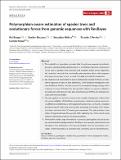Files in this item
Polymorphism‐aware estimation of species trees and evolutionary forces from genomic sequences with RevBayes
Item metadata
| dc.contributor.author | Borges, Rui | |
| dc.contributor.author | Boussau, Bastien | |
| dc.contributor.author | Höhna, Sebastian | |
| dc.contributor.author | Pereira, Ricardo J. | |
| dc.contributor.author | Kosiol, Carolin | |
| dc.date.accessioned | 2022-09-30T09:30:27Z | |
| dc.date.available | 2022-09-30T09:30:27Z | |
| dc.date.issued | 2022-09-22 | |
| dc.identifier | 281539320 | |
| dc.identifier | c5ab58cd-3054-4521-bfc2-706fc8b54151 | |
| dc.identifier | 85138504754 | |
| dc.identifier | 000856082800001 | |
| dc.identifier.citation | Borges , R , Boussau , B , Höhna , S , Pereira , R J & Kosiol , C 2022 , ' Polymorphism‐aware estimation of species trees and evolutionary forces from genomic sequences with RevBayes ' , Methods in Ecology and Evolution , vol. Early View , 13980 . https://doi.org/10.1111/2041-210x.13980 | en |
| dc.identifier.issn | 2041-210X | |
| dc.identifier.other | Jisc: 617145 | |
| dc.identifier.other | publisher-id: mee313980 | |
| dc.identifier.other | society-id: mee-22-02-083.r2 | |
| dc.identifier.uri | https://hdl.handle.net/10023/26108 | |
| dc.description | Funding information: Austrian Science Fund, Grant/Award Number: P34524-B; Biotechnology and Biological Sciences Research Council, Grant/Award Number: BB/W000768/1; Deutsche Forschungsgemeinschaft, Grant/Award Number: HO 6201/1-1; Vienna Science and Technology Fund, Grant/Award Number: MA016-061. | en |
| dc.description.abstract | 1. The availability of population genomic data through new sequencing technologies gives unprecedented opportunities for estimating important evolutionary forces such as genetic drift, selection and mutation biases across organisms. Yet, analytical methods that can handle polymorphisms jointly with sequence divergence across species are rare and not easily accessible to empiricists. 2. We implemented polymorphism-aware phylogenetic models (PoMos), an alternative approach for species tree estimation, in the Bayesian phylogenetic software RevBayes. PoMos naturally account for incomplete lineage sorting, which is known to cause difficulties for phylogenetic inference in species radiations, and scale well with genome-wide data. Simultaneously, PoMos can estimate mutation and selection biases. 3. We have applied our methods to resolve the complex phylogenetic relationships of a young radiation of Chorthippus grasshoppers, based on coding sequences. In addition to establishing a well-supported species tree, we found a mutation bias favouring AT alleles and selection bias promoting the fixation of GC alleles, the latter consistent with GC-biased gene conversion. The selection bias is two orders of magnitude lower than genetic drift, validating the critical role of nearly neutral evolutionary processes in species radiation. 4. PoMos offer a wide range of models to reconstruct phylogenies and can be easily combined with existing models in RevBayes—for example, relaxed clock and divergence time estimation—offering new insights into the evolutionary processes underlying molecular evolution and, ultimately, species diversification. | |
| dc.format.extent | 8 | |
| dc.format.extent | 1677508 | |
| dc.language.iso | eng | |
| dc.relation.ispartof | Methods in Ecology and Evolution | en |
| dc.subject | Genomics | en |
| dc.subject | Phylogenetics | en |
| dc.subject | Population genetics | en |
| dc.subject | Application | en |
| dc.subject | Applications | en |
| dc.subject | Bayesian inference | en |
| dc.subject | Grasshoppers | en |
| dc.subject | Mutation bias | en |
| dc.subject | Polymorphism‐aware phylogenetic models | en |
| dc.subject | RevBayes | en |
| dc.subject | Selection | en |
| dc.subject | Species tree | en |
| dc.subject | QH301 Biology | en |
| dc.subject | QH426 Genetics | en |
| dc.subject | DAS | en |
| dc.subject | MCC | en |
| dc.subject.lcc | QH301 | en |
| dc.subject.lcc | QH426 | en |
| dc.title | Polymorphism‐aware estimation of species trees and evolutionary forces from genomic sequences with RevBayes | en |
| dc.type | Journal article | en |
| dc.contributor.sponsor | BBSRC | en |
| dc.contributor.institution | University of St Andrews. Centre for Biological Diversity | en |
| dc.contributor.institution | University of St Andrews. School of Biology | en |
| dc.contributor.institution | University of St Andrews. St Andrews Bioinformatics Unit | en |
| dc.identifier.doi | 10.1111/2041-210x.13980 | |
| dc.description.status | Peer reviewed | en |
| dc.identifier.grantnumber | BB/W000768/1 | en |
This item appears in the following Collection(s)
Items in the St Andrews Research Repository are protected by copyright, with all rights reserved, unless otherwise indicated.

